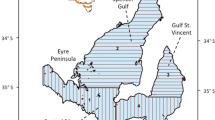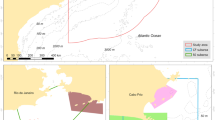Abstract
Very little is known about the ecology of common bottlenose dolphins (Tursiops truncatus) living in oceanic waters. This study investigated the ranging and residence patterns of bottlenose dolphins occurring in the Azores (Portugal), the most isolated archipelago in the North Atlantic. Data were collected during standardized boat-based surveys conducted over a 6-year period in an area of approximately 5,400 km2 (main study area). To investigate the extent of movements of individual animals, non-systematic surveys were also conducted outside this area. Only 44 individuals out of 966 identified were frequently sighted within and between years. The remaining individuals were either temporary migrants from within or outside the archipelago, or transients. Resident dolphins showed strong geographic fidelity to the area. Long-distance movements (of almost 300 km), consistent with foraging or exploratory trips, were observed among non-resident dolphins. Home range size was estimated for 31 individuals sighted ≥10 times. Range areas of these dolphins varied in size and location, but considerable overlap was observed in the areas used, suggesting the absence of habitat partitioning between resident and non-resident dolphins. Estimates of home range size of bottlenose dolphins in the Azores were found to be considerably larger than those previously reported for this species. It is hypothesized that dolphins living in the Azores carry out extensive movements and have large home ranges in response to the lower density and patchy distribution of prey compared to other areas. The extensive ranging behaviour and the lack of territoriality provide an opportunity for interbreeding between dolphins associated with different islands, thus preventing genetic differentiation within the population of the Azores.






Similar content being viewed by others
References
Baird RW, Ligon AD, Hooker SK, Gorgone AM (2001) Subsurface and nighttime behaviour of pantropical spotted dolphins in Hawai’i. Can J Zool 79:988–996. doi:https://doi.org/10.1139/cjz-79-6-988
Baird RW, Gorgone AM, Webster DL (2002) An examination of movements of bottlenose dolphins between islands in the Hawaiian island chain. Report prepared under contract #40JGNF110270 to the Southwest Fisheries Science Center, National Marine Fisheries Service, La Jolla
Ballance LT (1992) Habitat use patterns and ranges of the bottlenose dolphin in the Gulf of California, Mexico. Mar Mamm Sci 8:262–274. doi:https://doi.org/10.1111/j.1748-7692.1992.tb00408.x
Barton ED, Basterretxea G, Flament P, Mitchelson E, Jacob E, Jones B, Arlistegui J, Herrera F (2000) Lee region of Gran Canaria. J Geophys Res C 105:17173–17193. doi:https://doi.org/10.1029/2000JC900010
Benoit-Bird KJ, Au WWL (2003) Prey dynamics affect foraging by a pelagic predator (Stenella longirostris) over a range of spatial and temporal scales. Behav Ecol Sociobiol 53:364–373
Burt WH (1943) Territoriality and home range concepts as applied to mammals. J Mammal 30:25–27. doi:https://doi.org/10.2307/1375192
Caldeira RMA, Groom S, Miller P, Pilgrim D, Nezlin NP (2002) Sea-surface signatures of the island mass effect phenomena around Madeira Island, Northeast Atlantic. Remote Sens Environ 80:336–360. doi:https://doi.org/10.1016/S0034-4257(01)00316-9
Clutton-Brock TH (1989) Mammalian mating systems. Proc R Soc Lond B Biol Sci 236:1–39
Connor RC, Wells RS, Mann J, Read AJ (2000) The bottlenose dolphin: social relationships in a fission-fusion society. In: Mann J, Connor RC, Tyack PL, Whitehead H (eds) Cetacean societies: field studies of dolphins and whales. The University of Chicago Press, Chicago and London, pp 91–126
Damuth J (1981) Home range, home range overlap, and species energy use among herbivorous mammals. Biol J Linn Soc Lond 15:185–193. doi:https://doi.org/10.1111/j.1095-8312.1981.tb00758.x
Defran RH, Weller DW, Kelly DL, Espinosa MA (1999) Range characteristics of Pacific coast bottlenose dolphins (Tursiops truncatus) in the Southern California Bight. Mar Mamm Sci 15:381–393. doi:https://doi.org/10.1111/j.1748-7692.1999.tb00808.x
Fisher DO, Owens IPF (2000) Female home range size and the evolution of social organization in macropods marsupials. J Anim Ecol 69:1083–1098. doi:https://doi.org/10.1046/j.1365-2656.2000.00450.x
Ford RG (1983) Home range in a patchy environment: optimal foraging predictions. Am Zool 23:315–326
Gaustestad AO, Mysterud I (1995) The home range ghost. Oikos 74:195–204. doi:https://doi.org/10.2307/3545648
Genin A (2004) Bio-physical coupling in the formation of zooplankton and fish aggregations over abrupt topographies. J Mar Syst 50:3–20. doi:https://doi.org/10.1016/j.jmarsys.2003.10.008
Gubbins C (2002) Use of home ranges by resident bottlenose dolphins (Tursiops truncatus) in a South Carolina estuary. Aquat Mamm 83:178–187
Herfindal I, Linnell JDC, Odden J, Birkeland Nilsen E, Andersen R (2005) Prey density, environmental productivity and home-range size in the Eurasian lynx (Lynx lynx). J Zool (Lond) 265:63–71. doi:https://doi.org/10.1017/S0952836904006053
Hooge PN, Eichenlaub B (1997) Animal movement extension to arcview. ver. 1.1. Alaska Science Center—Biological Science Office, U.S. Geological Survey, Anchorage
Ingram SN, Rogan E (2002) Identifying critical areas and habitat preferences of bottlenose dolphins Tursiops truncatus. Mar Ecol Prog Ser 244:247–255. doi:https://doi.org/10.3354/meps244247
Irvine AB, Scott MD, Wells RS, Kaufmann JH (1981) Movements and activities of the Atlantic bottlenose dolphin, Tursiops truncatus, near Sarasota, Florida. Fish Bull (Wash D C) 79:671–688
Karczmarski L, Würsig B, Gailey G, Larson KW, Vanderlip C (2005) Spinner dolphins in a remote Hawaiian atoll: social grouping and population structure. Behav Ecol 16:675–685. doi:https://doi.org/10.1093/beheco/ari028
Kernohan BJ, Gitzen RA, Millspaugh JJ (2001) Analysis of animal space use and movements. In: Millspaugh JJ, Marzluff JM (eds) Radio tracking and animal populations. Academic Press, Sand Diego, pp 125–166
Krützen M, Sherwin WB, Berggren P, Gales N (2004) Population structure in an inshore cetacean revealed by microsatellite and mtDNA analysis: bottlenose dolphins (Tursiops sp.) in Shark Bay, Western Australia. Mar Mamm Sci 20:28–47. doi:https://doi.org/10.1111/j.1748-7692.2004.tb01139.x
Lusseau D, Wilson B, Hammond PS, Grellier K, Durban JW, Parsons KM, Barton TR, Thompson PM (2006) Quantifying the influence of sociality on population structure in bottlenose dolphins. J Anim Ecol 75:14–24. doi:https://doi.org/10.1111/j.1365-2656.2005.01013.x
Lynn SK (1995) Movements, site fidelity, and surfacing patterns of bottlenose dolphins on the central Texas coast. MS Thesis, Texas A&M University
Mann J, Smuts B (1999) Behavioral development in wild bottlenose dolphin newborns (Tursiops sp.). Behaviour 136:529–566. doi:https://doi.org/10.1163/156853999501469
McLoughlin PD, Ferguson SH (2000) A hierarchical pattern of limiting factor helps explain variation in home range size. Ecoscience 7:123–130
McNab BK (1963) Bioenergetics and the determination of home range size. Am Nat 894:133–140. doi:https://doi.org/10.1086/282264
Mohr CO (1947) Table of equivalent populations of North American small mammals. Am Midl Nat 37:223–249. doi:https://doi.org/10.2307/2421652
Norris KS, Dohl TP (1980) The structure and functions of cetacean schools. In: Herman LM (ed) Cetacean behaviour: mechanisms and function. Wiley, USA, pp 211–261
Owen ECG, Wells RS, Hofmann S (2002) Ranging and association patterns of paired and unpaired adult male Atlantic bottlenose dolphins, Tursiops truncatus, in Sarasota, Florida, provide no evidence for alternative male strategies. Can J Zool 80:2072–2089. doi:https://doi.org/10.1139/z02-195
Palacios DM (2002) Factors influencing the island-mass effect of the Galápagos Archipelago. Geophys Res Lett 29:2134–2138. doi:https://doi.org/10.1029/2002GL016232
Quérouil S, Silva MA, Freitas L, Prieto R, Magalhães S, Dinis A, Alves F, Matos JA, Mendonça D, Hammond P, Santos RS (2007) High gene flow in oceanic bottlenose dolphins (Tursiops truncatus) of the North Atlantic. Conserv Genet 8:1405–1419. doi:https://doi.org/10.1007/s10592-007-9291-5
Sandell M (1989) The mating tactics and spacing behaviour of solitary carnivores. In: Gittleman JL (ed) Carnivore behaviour, ecology and evolution. New York, Cornell University Press, pp 164–182
Santos RS, Hawkins S, Monteiro LR, Alves M, Isidro E (1995) Marine research, resources and conservation in the Azores. Aquat Conserv Mar Freshw Ecosyst 5:311–354. doi:https://doi.org/10.1002/aqc.3270050406
Schoener TW (1981) An empirically based estimate of home range. Theor Popul Biol 20:281–325. doi:https://doi.org/10.1016/0040-5809(81)90049-6
Scott MD, Wells RS, Irvine AB (1990) A long-term study of bottlenose dolphins on the west coast of Florida. In: Leatherwood S, Reeves RR (eds) The bottlenose dolphin. Academic Press, San Diego, pp 235–244
Seaman DE, Millspaugh JJ, Kernohan BJ, Brundige GC, Raedeke KJ, Gitzen RA (1999) Effects of sample size on kernel home range estimates. J Wildl Manage 63:739–747. doi:https://doi.org/10.2307/3802664
Shane SH (2004) Residence patterns, group characteristics, and association patterns of bottlenose dolphins near Sanibel Island, Florida. Gulf Mex Sci 1:1–12
Silva MA (2007) Population biology of bottlenose dolphins in the Azores Archipelago. PhD thesis, University of St Andrews
Silva MA, Prieto R, Magalhães S, Cabecinhas R, Cruz A, Gonçalves JM, Santos RS (2003) Occurrence and distribution of cetaceans in the waters around the Azores (Portugal), Summer and Autumn 1999–2000. Aquat Mamm 29:77–83. doi:https://doi.org/10.1578/016754203101024095
Stevick PT, McConnell BJ, Hammond PS (2002) Patterns of movement. In: Hoelzel AR (ed) Marine mammal biology: an evolutionary approach. Blackwell Publishing, Oxford, pp 185–216
Swihart RK, Slade NA (1997) On testing for independence of animal movements. J Agric Biol Environ Stat 2:48–63. doi:https://doi.org/10.2307/1400640
Swihart RK, Slade NA, Bergstrom BJ (1988) Relating body size to the rate of home range use in mammals. Ecology 69:393–399. doi:https://doi.org/10.2307/1940437
Tempera F, Afonso P, Morato T, Prieto R, Silva M, Cruz A, Gonçalves J, Santos RS (2001) Comunidades biológicas marinhas dos Sítios de Interesse Comunitário do Canal Faial-Pico. Arquivos do DOP. Ser Relatorio Internos 5:1–95
Urian KW (2002) Community structure of bottlenose dolphins (Tursiops truncatus) in Tampa Bay, Florida, USA. MS thesis, University of North Carolina
Walton MJ, Silva MA, Magalhães S, Prieto R, Santos RS (2007) Using blubber biopsies to provide ecological information about bottlenose dolphins Tursiops truncatus around the Azores. J Mar Biol Assoc U K 87:223–230. doi:https://doi.org/10.1017/S0025315407054537
Wells RS, Irvine AB, Scott MD (1980) The social ecology of inshore odontocetes. In: Herman LM (ed) Cetacean behaviour: mechanisms and function. Wiley, New York
Wells RS, Scott MD, Irvine AB (1987) The social structure of free-ranging bottlenose dolphins. In: Genoways H (ed) Current mammalogy. Plenum Press, New York, pp 247–305
White GC, Garrott RA (eds) (1990) Analysis of wildlife radio-tracking data. Academic Press, San Diego
Wiens JA (1976) Population responses to patchy environments. Annu Rev Ecol Syst 7:81–120. doi:https://doi.org/10.1146/annurev.es.07.110176.000501
Wilson B, Thompson PM, Hammond PS (1997) Habitat use by bottlenose dolphins: seasonal distribution and stratified movement patterns in the Moray Firth, Scotland. J Appl Ecol 34:1365–1374. doi:https://doi.org/10.2307/2405254
Wilson B, Hammond PS, Thompson PM (1999) Estimating size and assessing trends in a coastal bottlenose dolphin population. Ecol Appl 9:288–300. doi:https://doi.org/10.1890/1051-0761(1999)009[0288:ESAATI]2.0.CO;2
Worton BJ (1989) Kernel methods for estimating the utilization distribution in home-range studies. Ecology 70:164–168. doi:https://doi.org/10.2307/1938423
Würsig B, Jefferson TA (1990) Methods of photo-identification for small cetaceans. Rep Int Whal Comm Spec Issue 12:43–52
Acknowledgments
This research was funded by the Portuguese Science and Technology Foundation (FCT), under the CETAMARH project (POCTI/BSE/38991/01), by an EU-LIFE program (B4-3200/98/509), and by an Interreg program (Interreg IIIBMAC/4.2/A2). We are also grateful to FCT for funding M. A. S. doctoral grant (SFRH/BD/8609/2002) and post-doctoral grants (SFRH/BPD/29841/2006), and S. M. M. and M. I. S. research grants through the CETAMARH project. We are thankful to the skippers (Filipe Goulart, P. Martins, V. Rosa, R. Bettencourt and N. Serpa), crew members, students and volunteers that helped us throughout this study. We also thank David Lusseau and three anonymous reviewers for their comments on an early draft of the manuscript. IMAR-DOP/UAç is the R&D Unit #531 funded through the pluri-annual and programmatic funding schemes of FCT-MCTES and DRCT-Azores. This research was conducted under license of the Environment Directorate of the Regional Government of the Azores.
Author information
Authors and Affiliations
Corresponding author
Additional information
Communicated by R. Lewison.
Rights and permissions
About this article
Cite this article
Silva, M.A., Prieto, R., Magalhães, S. et al. Ranging patterns of bottlenose dolphins living in oceanic waters: implications for population structure. Mar Biol 156, 179–192 (2008). https://doi.org/10.1007/s00227-008-1075-z
Received:
Accepted:
Published:
Issue Date:
DOI: https://doi.org/10.1007/s00227-008-1075-z




